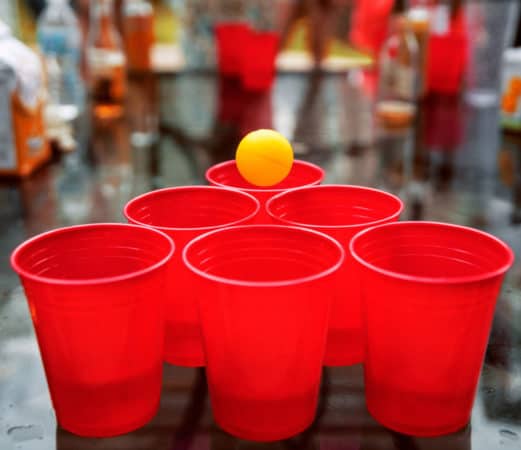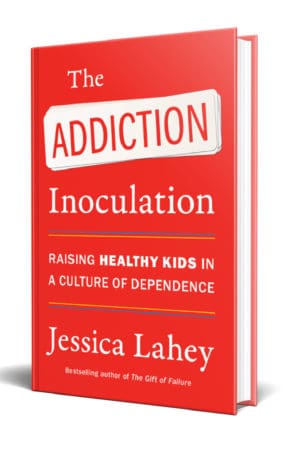When I set out to write The Addiction Inoculation: Raising Healthy Kids in a Culture of Dependence, I never planned to include a chapter on college. I, like so many other people, believed the Animal House myths: that college and drinking are inextricably linked, no matter what colleges or parents do.
Once I started reading the research, however, I added the college chapter back in, because the reality of college drinking is very different — and less pervasive — than our flawed perception.
Developmentally, breaking rules, drinking to excess, and doing exactly the opposite of what parents want kids to do makes perfect sense. Adolescence, and especially the tail end of it, when young adults are living away from home yet still spend summer in their childhood bedrooms, when they are still financially dependent on parents (and no matter how little they want to admit it, a little emotionally dependent, too), is confusing. In the college years, individuation, the process of pulling away from parents and becoming their own person, is push-and-pull.

It’s important for our teens to know who’s drinking and how much
While most older adolescents test the boundaries of their independence and ability to handle risks away from home, it’s especially important for them to have a realistic understanding of who is drinking and how much.
Where college drinking is concerned, perception drives reality. Sociologists call this phenomenon “pluralistic ignorance,” and it’s a powerful force on college campuses. Despite the ubiquity of the beer-funneling, shot-pounding, barely conscious college student stereotype depicted in movies and television, this experience is far from the norm. However, our societal belief in this stereotype fuels expectations around college drinking habits undermines enforcement of underage drinking laws, and increases the amount of alcohol consumed on college campuses.
Pluralistic ignorance has a powerful influence on behavior
The authors of my favorite academic paper on the topic, “Pluralistic Ignorance and Alcohol Use on Campus: Some Consequences of Misperceiving the Social Norm,” conducted experiments at Princeton University that reveal just how powerful pluralistic ignorance around substance use can be.
Alcohol is (or was around the time the experiments were conducted, in the late eighties and early nineties) important to the social scene at Princeton for both enrolled students and visiting alumni. According to the authors,
Princeton reunions boast the second highest level of alcohol consumption for any event in the country after the Indianapolis 500. The social norms for drinking at the university are clear: Students must be comfortable with alcohol use to partake of Princeton social life.
First, the authors had students complete questionnaires about their private feelings around drinking at Princeton, questions like, “How comfortable do you feel with the alcohol drinking habits of students at Princeton?” and “How comfortable does the average Princeton undergraduate feel with the alcohol drinking habits of students at Princeton?”
In the second iteration of the study, they tweaked their questionnaire and added an extra question that asked students to rate their friends’ attitudes about drinking. The authors found that individual students expressed discomfort with drinking on campus, but they also believed the average Princeton student, as well as their friends, was more comfortable with drinking on campus than they were.
Men change their behavior in accordance with misconceptions of community norms and women disengage
Next, they asked second-year students the same questions, then interviewed them again eight weeks later. The results bore out their prediction that people would internalize their misperceptions of the community norms and bring their own behavior into line.
Turns out men and women experienced the same levels of ignorance around substance use, but their responses were very different. The men changed their behavior to adhere to what they believed the community norms about drinking to be, but women did not. Women, when faced with the idea that others value drinking more than they do (even though this belief is untrue), feel alienated and disengage from the group, and that alienation increases over time.
Finally, the authors capitalized on their timing: Princeton’s president had recently instituted a campus-wide ban on kegs of beer as a way to pay lip service to the many people who were concerned about the high rate of alcohol use on campus.
As soon as it was announced, the ban was met with massive disapproval, but the authors suspected that students’ private attitudes might not be as negative as the public outcry. The authors’ survey found that overall, students were convinced everyone else on campus had stronger negative emotions about the keg ban than they did.
Perceptions about college drinking shape reality
The consequences of these findings are significant and worth discussing before kids head off to college. Perception shapes reality: alcohol continues to play a key role in college social life not because students want or need alcohol to be a part of the festivities, but because the individual students organizing the festivities believe other students will want to drink and expect it to be available.
This also means that alcohol-free options will remain rare because kids (or staff) mistakenly believe that no one will come if alcohol isn’t being served. Finally, people who feel alienated are less likely to act to change group norms (think about the kid who does not understand the lesson but won’t raise his hand).
So, given that we completely overestimate the drinking that happens on college campuses, what is the reality?
The number of college students who drink has hovered around 44 percent for years, and the statistical average number of drinks per week for college students is five. However, this number is deceptive, because the heaviest-drinking college students consume 68 percent of all the alcohol drunk on campus, and the heaviest binge drinkers chug 72 percent of all alcohol consumed by college students.
Who binge drinks on college campuses?
Who are these binge drinkers? White men under twenty-four. Students who live in the Greek system (four out of five students who live in fraternities and sororities are classified as binge drinkers). Sorority and fraternity presidents (Greek leaders not only drink the most, they also set the norms for drinking within the house). Student-athletes (29 percent of student-athletes are binge drinkers, but again, this figure is deceptive because rates are disproportionately higher among athletes in high-contact sports: football, hockey, lacrosse, and wrestling).
Kids who intend to drink in college, who rank parties as important, and who look forward to and romanticize drinking culture, drink more in college. Finally, students whose personalities can be described as pleasure-seeking, extroverted, impulsive rebellious, and nonconforming drink more often, in greater amounts, and with more negative consequences than other college students.
Who is least likely to drink on college campuses?
As for the rest of the kids on campus? They don’t drink very much. Fifty-six percent of students on campus do not binge drink, and consume just 9 percent of the alcohol consumed on campus. The students least likely to binge are African Americans (especially African American women), Asians, students over twenty-four, students who are married, students who prioritize academics or activities such as music or art, and students who volunteer their time. Students at religion-oriented colleges and universities and armed-forces-affiliated institutions have much lower levels of alcohol consumption.
It’s never too late to start talking about drug and alcohol use, and in these final few years of the parenting push-and-pull, we should let reality drive both their decisions and their drinking habits.










